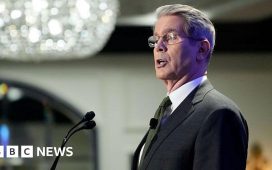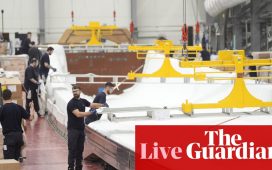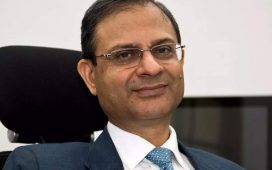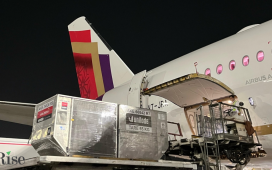Unlock the Editor’s Digest for free
Roula Khalaf, Editor of the FT, selects her favourite stories in this weekly newsletter.
The clue was on the cover of Rishi Sunak’s multibillion-pound vision for new northern infrastructure projects.
Adorning his master plan was a map, on which someone had taken an unusual executive decision — moving Manchester roughly to where Preston is, more than 30 miles north. Which is, to give the government its due, a genuinely radical policy.
Sunak’s blueprint, the centrepiece of this year’s party conference speech, was supposed to present the more politically popular alternative to the northern leg of HS2. But mislocating Manchester was only the start. The launch of “Network North”, which as many pointed out is neither a network nor, to a significant extent, in the north, then proceeded less like a slow-moving train wreck and more — ironically — like a high-speed one.
The prime minister had finally cancelled HS2’s northern leg, in spectacular optics, in a former Victorian railway exchange building in Manchester that dates back to the last time we built serious transport projects in the north of England. But this stunning, almost surreal juxtaposition of speech and setting then seemed to morph into policy as performance art.
Sunak’s alternative transport plan, which began to unravel in less than 24 hours, featured two tram extensions to places that have already had a tram for the best part of a decade; the reopening of the Leamside line in the north-east, an announcement met with such delight that it was swiftly deleted from the plan; a new mass transit network for Bristol, also swiftly deleted; and a project for Southampton that was intended for Littlehampton.
Ministers then confirmed that a £100mn study aimed at determining how to get high-speed trains to Leeds in the future — this was only promised in the first place as consolation for cutting the city out of HS2 two years ago — was also being cancelled. Local leaders had only received the terms of reference for that study a few weeks earlier.
So much for the plans outside the capital. But the Department for Transport then confirmed that — oops — the HS2 terminus in Euston is now unfunded, so cannot be guaranteed.
By this week, Sunak said some of the projects he had announced were merely “illustrative”. Mere transport vibes, if you will. A gobsmacked local government contact objected to the constant improvisation: “I love jazz, but not in a policy development sense.”
Meanwhile, although the government insists it is committed to everything not now deemed “illustrative”, each proposed investment still needs to be signed off “on a case-by-case basis”, according to the DfT, which is hard to reconcile with a definite outcome.
It should be stressed that this whimsical approach to planning British infrastructure is not unprecedented. In Manchester, the government only got around to building one element of its plan to unclog the notorious northern rail bottleneck in the city’s centre. Because ministers had cancelled the other elements, the section they did build actually made the situation worse.
There were the endless changes to plans for electrification across the Pennines, which wasted £190mn according to the National Audit Office. And as for the dualling of the A1 in Northumberland, promised once again by Sunak last week, the list of all the other times it has already been promised is quite a read.
The prime minister’s approach is certainly a courageous way to plan something so fundamental to the national economy and, in particular, the north’s prosperity. It is also a reminder of why the narrative from Greater Manchester’s Labour mayor, Andy Burnham, (broadly summarised as “London doesn’t care about us”), has proved so electorally successful; and why polls show voters are deeply sceptical, particularly in the north-west and Yorkshire, about transport promises.
It remains to be seen just how committed an incoming Labour government might be to such projects, particularly an east-west high-speed rail network across the north, to which it had originally been signed up. The real counter to the government chaos has not been from the main opposition front bench, but in the pragmatic response from regional political and business leaders.
Attempts to draw up an alternative funding model for the northern leg of HS2 have not entirely been abandoned. Burnham and his Conservative counterpart in the West Midlands, Andy Street, hope that through land value capture (levying businesses that will see an increase in the value of their assets as a result of improved rail links) or through direct private investment, or a mix, high-speed rail could yet get as far as the north.
The initial rage at Sunak’s decision has calcified into determination to find a sensible solution without Westminster or Whitehall — drawn up by people who can, at the very least, find the north’s biggest city on a map.









